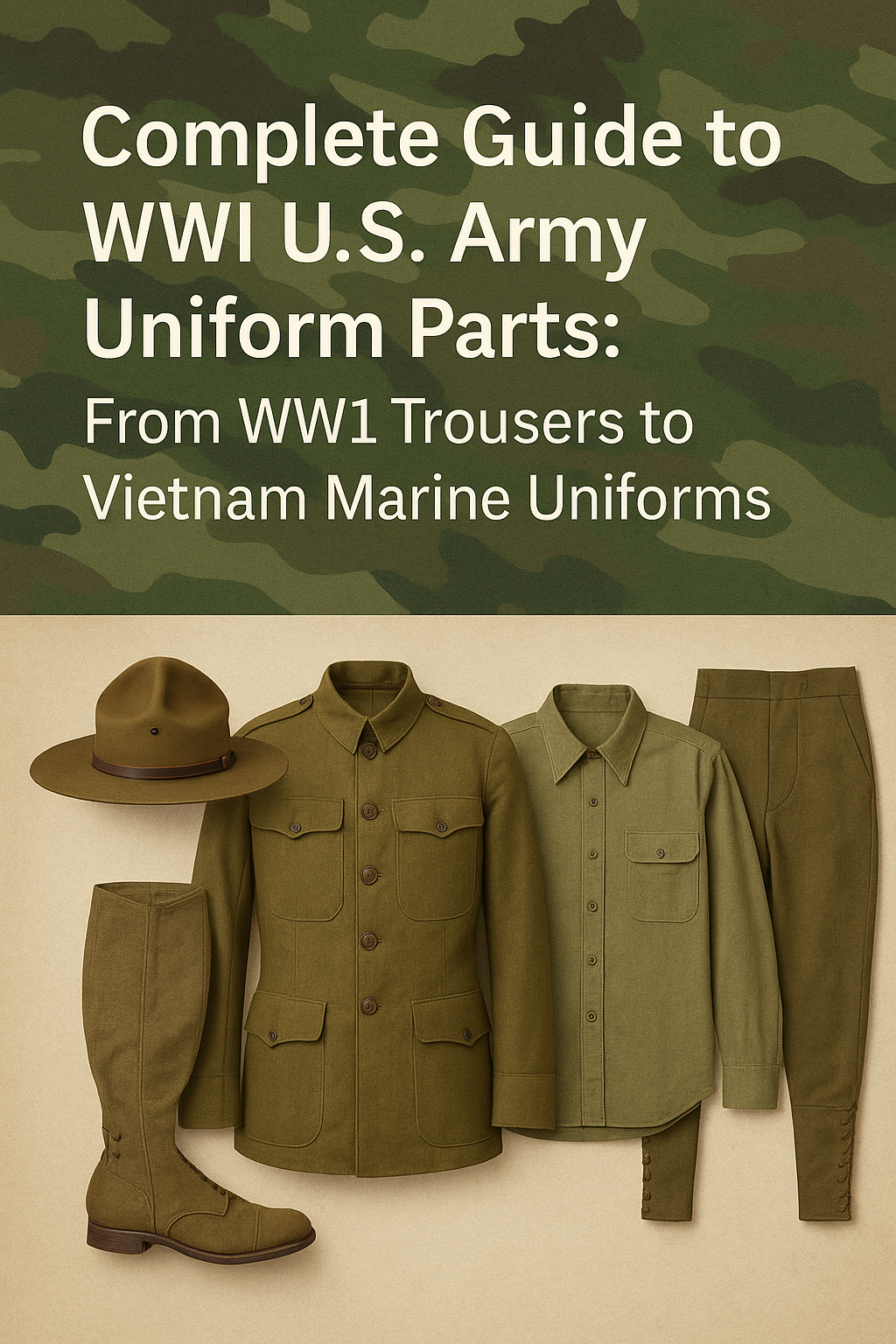
Complete Guide to WWI U.S. Army Uniform Parts: From WW1 Trousers to Vietnam Marine Uniforms"
Published on Jun 19, 2025
Complete Guide to WWI U.S. Army Uniform Parts: From WW1 Trousers to Vietnam Marine Uniforms
Military uniforms are not just clothing—they’re powerful historical artifacts. Each piece tells a story about the soldier who wore it, the battles it saw, and the era it represents. During World War I, the U.S. Army uniform underwent significant changes to adapt to the modern warfare of the era. In this guide, we’ll break down the essential components of the WWI U.S. Army uniform, with special attention to items such as WWI trousers, army dress shirts, and the enduring appeal of later uniforms, including the Vietnam Marine uniform and Army dress greens.
The Significance of Uniforms in World War I
During World War I, the U.S. Army transitioned from traditional blue uniforms to the more practical olive-drab (OD) woolen field uniforms. This change reflected a broader shift toward functionality and camouflage. As the United States entered the war in 1917, the demand for standardized, durable, and climate-appropriate military attire became crucial.
1. WW1 Trousers: A Practical Innovation
World War I trousers, also known as breeches, were among the most recognizable parts of the uniform. Typically made from heavy wool in olive drab or mustard hues, they were designed for rugged use in the trenches.
Key Features:
- High-waisted with belt loops and suspenders
- Laced cuffs or puttees at the calves to keep out mud
- Reinforced seat and knee areas for durability
The trousers were worn with wool leggings or leather puttees wrapped around the lower legs, which offered additional protection and support.
Reproduction and Collecting:
Today, WW1 trousers are sought after by collectors and reenactors. Reproduction pants with period-accurate stitching and fabric are available at specialized shops like Paddelaters.com, making it easier to complete your historical ensemble.
2. Army Dress Shirt: Formality in Function
The army dress shirt served both practical and ceremonial roles. While soldiers often wore wool service shirts in the field, the dress shirt was part of the garrison uniform for non-combat duties and formal occasions.
Characteristics:
- Made from wool flannel or cotton
- Button-front with breast pockets
- Often paired with a tie and service coat
Shirts from this era often bear stamps or labels indicating the manufacturer, unit, or date of issue—features that increase their value among collectors.
3. The Evolution: Vietnam Marine Uniform
Though separated by several decades, the Vietnam Marine uniform reflects an evolution in U.S. military attire. Vietnam-era uniforms introduced lighter materials, such as cotton ripstop, for tropical climates, a departure from the wool-heavy garments of World War I.
Notable Differences:
- Camouflage patterns and jungle boots
- Utility shirts with slanted pockets
- Durable but lightweight materials
Military collectors and history enthusiasts prize the Vietnam Marine uniform for its connection to one of the most pivotal conflicts of the 20th century. It’s also a useful comparative lens to highlight how uniforms adapted to different combat environments.
4. Army Dress Greens Uniform: A Modern Classic
The Army dress greens replaced the khaki service uniforms in the 1950s and remained in use until the 2000s. Known for their tailored appearance, these uniforms signified professionalism and pride.
Key Components:
- Forest green coat and trousers
- White shirt and black tie
- Sometimes referred to as “pinks and greens” due to color variation
Interestingly, the "pink and green" style has seen a revival in modern military circles. You can now find army pinks and greens for sale, offering a nostalgic nod to mid-20th-century military fashion.
5. Putting It All Together: Full WWI U.S. Army Uniform Breakdown
To assemble a historically accurate WWI U.S. Army uniform, here’s what you’ll need:
Uniform ComponentDescription
Field Cap (Campaign Hat or Overseas Cap) Felt wide-brimmed hat or soft side cap worn in trenches.
Tunic (Service Coat) Wool, four-pocket design, sometimes belted
WW1 Trousers (Breeches) Wool, laced at the calves
Army Dress Shirt , Wool or cotton, worn under the tunic
Leggings or Puttees Wrapped around the calves
Brogans or Trench Boots Leather, hobnailed soles
Accessories : Gas mask bag, ammunition pouches, canteen, dog tags
6. Where to Buy Authentic and Reproduction Uniforms
Finding high-quality, historically accurate uniform parts can be a challenge—but platforms like Paddelaters.com make the process easier. Whether you’re looking for:
- WW1 trousers
- An authentic army dress shirt
- Vietnam marine uniforms
- Army pinks and greens for sale
You’ll find both reproduction and original pieces to suit reenactors, collectors, or educators.
7. Why Accurate Uniforms Matter
Authentic uniform details not only enhance the reenactment experience but also help preserve history. Uniforms serve as educational tools in museums, classrooms, and historical displays. Wearing a full World War I uniform brings the past to life and honors those who served.
Final Thoughts
The U.S. Army uniforms of World War I tell a story of innovation, adaptation, and national pride. From the rugged design of WW1 trousers to the enduring legacy of the army dress greens, each piece is a chapter in American military history. Whether you’re collecting, reenacting, or just fascinated by wartime attire, knowing the parts of the uniform—and where to find them—is key.
Start your search today at Paddelaters.com, your go-to source for authentic and reproduction military uniforms and accessories.
